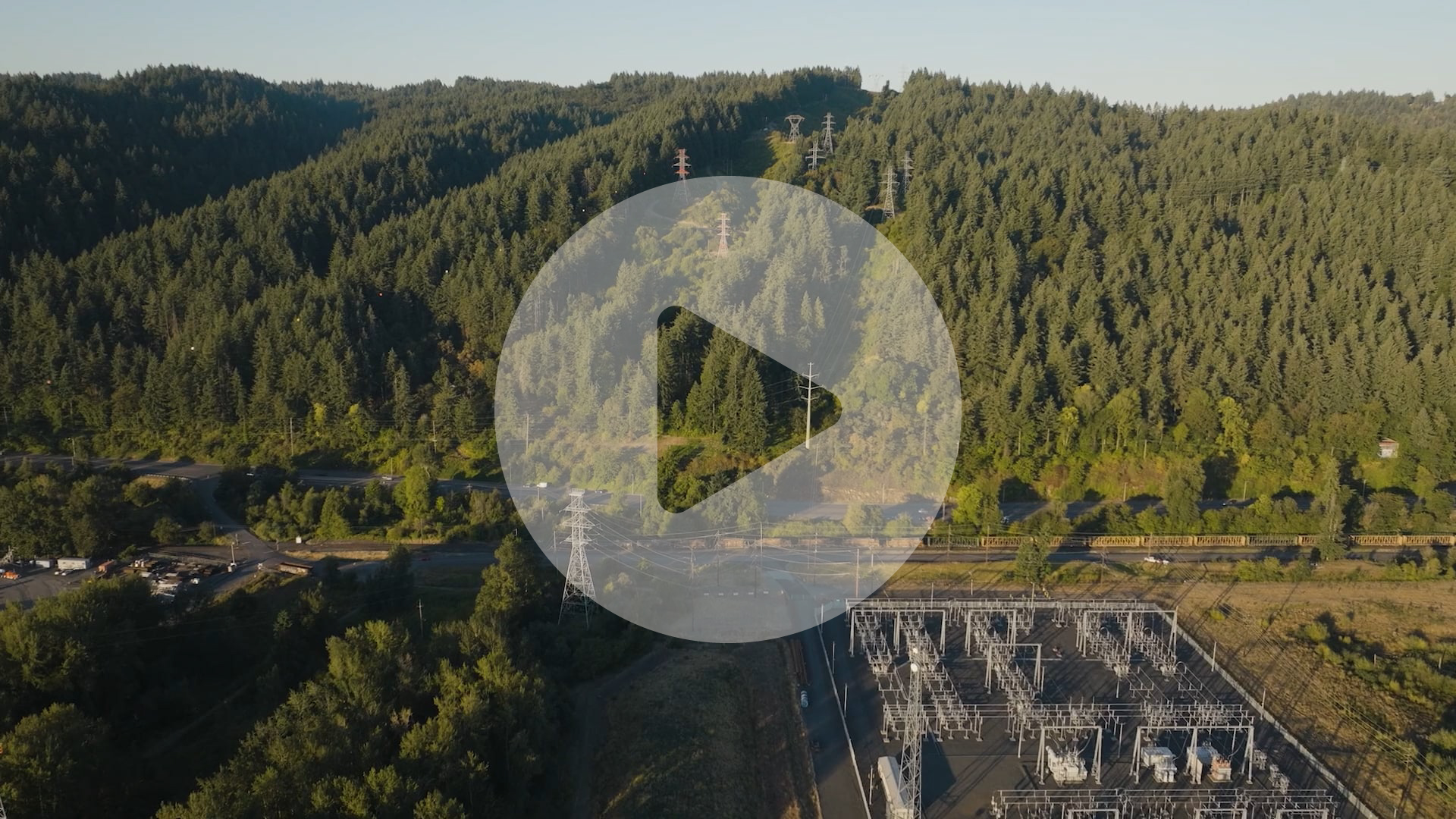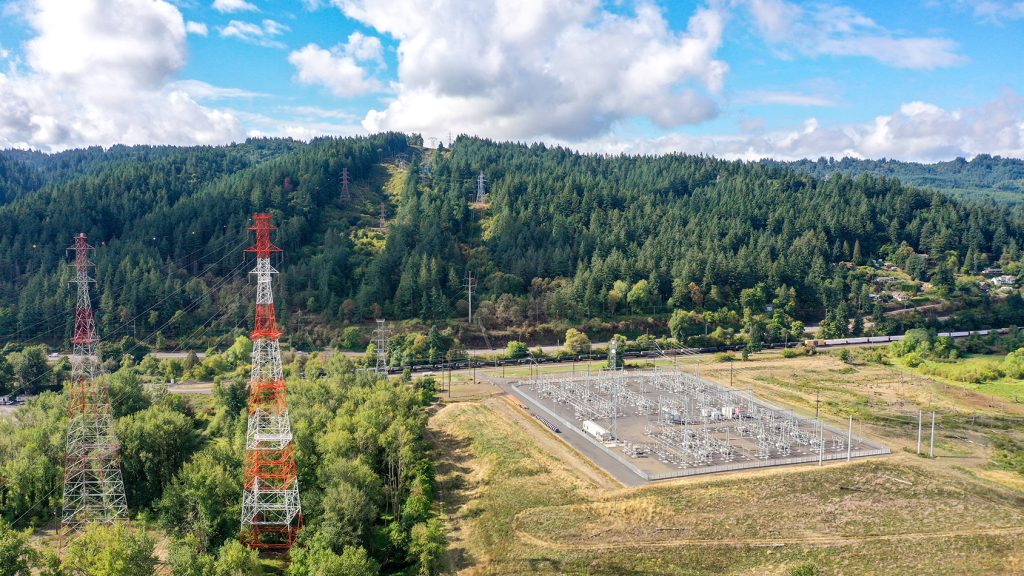Legend
Harborton Reliability Project
Aging infrastructure is a challenge, nationwide. One of our most critical needs is a stronger, more modern power grid that can deliver reliable power, meeting our needs today and as we move to a cleaner energy future that will help address climate change.
The Harborton Reliability Project is a key, immediate part of providing reliable electricity to power our homes, economy, and lives. This portion of a multi-phase project will make needed equipment upgrades and add transmission capacity into Portland and throughout our service area. It will resolve a critical bottleneck in the grid and help meet future demand, especially as extreme weather becomes more frequent.
This phase will upgrade an existing transmission line that connects the Harborton substation to the west and will add a new quarter-mile line to increase reliability. The work will take place within an existing utility right-of-way that already contains power lines. Making these improvements will require removing approximately five acres of trees from the 5,200-acre park. Two future phases that could occur within existing utility easements are in the earliest planning stages.

Timeline
Overall Project Time
Permitting
Construction Season 1 - Access Roads and Site Development
No Work: Stabilized for Winter
Construction Season 2 - Powerline Construction
Site Restoration, Mitigation Installation
Periodic Monitoring, Reporting (End Date TBD)
Timeline is approximate and subject to change.

Need and Purpose
The Harborton Reliability Project is a critical upgrade to the electrical system that serves our community, meeting immediate and longer-term needs. The existing system is outdated and cannot transmit electricity at the levels required today and needed to meet future demand, especially in increasing extreme weather events. To meet growing and projected demand for electricity and avoid outages projected in 2028 without these improvements, it is critical PGE start construction on this phase by 2025 and complete it by the end of 2027.
Questions? Comments? Contact PGE at PGEprojects@pgn.com.
Photo Simulations
These photo simulations help provide an accurate and realistic depiction of a planned project. They use photography and detailed 3D renderings to create ‘before and after’ simulations of the project at different locations. Simulations consider the width of the right of way, vegetation management requirements, environmental considerations, visual impacts, and material finishes to help illustrate how the proposed project may look when it is built. Note that photo simulations are approximations for illustrative purposes and to facilitate discussion. Final engineering and construction details may change pending public, regulatory, and utility review.
There are two ways to use this tool:
- On the overview map, click the photo simulation icon at any of the locations. Click ‘view simulation’ on the photo that pops up. Click and drag the slider to see the transition between existing and proposed conditions.
- In the project segments, click the photo simulation of interest. Click and drag the slider to see the transition between existing and proposed conditions.
Information Resources
Project
Oregon Land Use Board of Appeals
Portland City Council Hearing of Appeal
City of Portland Land Use Hearing
- PGE Presentation
- Resubmission of Legal Testimony to Hearings Officer
- Exhibit 20 – Brickworkers and Allies
- Exhibit 50 – Metro Chamber
- Exhibit 52 – Trimet
- Exhibit 221 – IBEW 48
- Exhibit 222 – IBEW 48
- Exhibit 224 – IUOE
- Exhibit 225 – IUOE
- Exhibit 236 – Port of Portland
- Exhibit 303 – Joint Support Columbia Corridor
- Exhibit 321 – Working Waterfront Coalition
- Exhibit 324 – Greater Portland Inc
- Exhibit 334 – Central Eastside
- Exhibit 397 – District Council of Laborers
- Exhibit 431 – Applicant Submission BPA LURR Letter
- Exhibit 436 – IBEW 48 Letters
- Exhibit 438 – Oregon Business for Climate
- Exhibit 441 – Operating Engineers 701
- Exhibit 450 – Roofers Local 49
- Exhibit 453 – IBEW 48
- Exhibit 477 – Local 36 Letters
- Exhibit 487 – Columbia Pacific Building and Construction Trades Council Letter
- Exhibit 496 – Laborers Local 737
- Exhibit 516 – Ironworkers Local 29 Letters
- Exhibit 518 – Roofers Waterproofers & Allied Workers Local 49 Letters
- Exhibit 647 – Renewable Northwest
- Exhibit 720 – NECA Oregon-Columbia
- Exhibit 722 – NECA NW Line Constructors
- Exhibit 843 – Randy Hardy
Land Use Application LU 24-041109
- Decision of the Hearings Officer
- PGE LU Narrative
- Incompleteness Comments Response
- Alternative Route Assessment (Toth Report), Oct. 2022
- Appendix A Early Assistance Meeting Summary
- Appendix B Arborist Report Tree Protection Plan
- Appendix C Alternatives Analysis
- Appendix D Mitigation Plan
- Appendix E Site Photos
- Appendix F Existing PGE Utility Easement in Forest Park
- Appendix G Greenway Evaluation
- Appendix H Tree Mortality Data and Trends in PGE Service Territory
- Appendix I Joint Letter from Former Commissioner Hales and Blumenauer
- Appendix J PGE Harborton Geotechnical Report
- Exhibit A Land Use Review Application Form
- Exhibit B Vicinity Map
- Exhibit C Overall Site Plan Aerial Tree Tables
- Exhibit D Existing Conditions
- Exhibit E Proposed Development 11×17
- Exhibit E Proposed Development 22×34
- Exhibit F Construction Management Plan 11×17
- Exhibit F Construction Management Plan 22×34
- Exhibit G Mitigation Site Plan
Community Meetings
Updated FAQs – September 2025
The Facts: In May, Portland’s City Council granted the appeal from opponents of PGE’s plan to upgrade its transmission lines in Forest Park, reversing the findings of a City of Portland hearings officer. PGE filed a notice of intent to appeal that decision to the Oregon Land Use Board of Appeals (LUBA) and introduced the possibility of mediation in pursuit of our shared interests in serving Portlanders and in pursuit of PGE’s obligation to reliably serve customers. The City of Portland has agreed to explore mediation, as have intervenors both in support of and opposing the project. Timing for mediation is being determined.
The Facts: Some neighborhood members support the proposed project out of concerns that a route proposed by project opponents would dramatically affect their homes, businesses and neighborhoods. Others, including the Forest Park Neighborhood Association, Forest Park Conservancy and Oregon Bird Alliance, oppose the proposed project within PGE’s right of way in Forest Park and prefer it to be located elsewhere.
The Facts: PGE and the City have a shared interest in maintaining reliable power to Portlanders into the future. This project is urgently needed and the only viable way to resolve the transmission bottleneck and the least impactful, affecting about one-tenth of one percent of Forest Park. Other alternatives do not resolve the transmission bottleneck or would:
- Require condemning private property
- Affect Forest Park and additionally impact other environmentally and culturally sensitive areas
- Increase the cost of the project that all customers would bear
The Facts: This depends on LUBA’s findings. LUBA could uphold the City’s decision, or the application could be remanded back to City Council for reconsideration.
The Facts: PGE’s application addressed the project need and urgency in clear and compelling terms in multiple locations, including:
- The executive summary of the Land Use Narrative (Revised 10.28.24), Section A3 on pages 13-14
- Alternative Route Assessment (Toth Report), page 3
- Appendix C Alternative Route Analysis, Section 1.1 Purpose and Need through Section 1.4 proposed Project Goals and Objections, pages 1-7
The Facts: We are eager for fast and immediate collaboration with the city to move the project forward in service to our shared goals for the city and the region, and toward a solution that recognizes our commitment to customers to deliver reliable, increasingly clean electricity while keeping costs as low as possible.
FAQ
The Facts: No, this project does not involve clearcutting. Clearcutting implies large-scale indiscriminate logging of a complete forest with all of its ecological benefits. In contrast, this project involves selectively removing 376 trees and leaving several hundred trees in place within a 5-acre project area that is within a 5,200-acre forest that remains ecologically rich. The trees selected must be removed to prevent safety hazards.
PGE retained a board-certified master arborist to review a tree inventory and to assess the conditions of over 700 trees in the project area, in order to protect the maximum number of trees and to remove or top the minimum number of trees to only those necessary.
The Facts: No. Although the project would affect mature trees, the forest in the proposed project area is not ancient and it does not contain old growth habitat. It includes typical mixed-age forest dominated by Douglas fir and big-leaf maple, which together comprise the most common and abundant type of habitat throughout all of Forest Park.
The proposed project would remove a mix of young and mature trees in an area completely surrounded by existing power lines. As such, it would not fragment habitat beyond the existing utility right-of-way. As part of a multi-faceted restoration plan, PGE is proposing planting 398 Oregon white oaks in the utility easement and 418 other short stature trees in the park. Oak habitat was once common, though is now highly vulnerable and considered an “Oregon Conservation Strategy Habitat.”
The Facts: The Harborton Reliability Project is potentially a multi-stage project. Phase 1 is complete, and Phase 2 is currently underway. The current Phase 3 project is the only project that is planned and proposed within Forest Park. For transparency’s sake, PGE shared that at some future point, two additional projects could be necessary, involving existing transmission lines within existing right-of-ways. PGE is in the very earliest stages of analysis and planning, which will include evaluating ways to maximize the capacity of existing equipment, and assessing the needs, options and potential impacts of any future possible project and alternatives. PGE would put any future proposed project through the same rigorous analysis as it has for Phase 3, in anticipation that it would go through the same scrutiny and review by land use and potentially City of Portland officials.
The Facts: The Harborton Reliability Project will serve residential and commercial customers in North and Northwest Portland by increasing voltage and capacity of a part of our system that was built in the 1970’s. Demand for electricity has risen since then and is continuing to rise due to building and vehicle electrification, and economic development.
The Facts: Since 2015, PGE has identified the Harborton Reliability Project as a necessary grid improvement to meet anticipated demand for electricity and capacity constraints. That predates the planned growth of major customers and the more recent and rapid expansion of data centers. This project will primarily serve homes and businesses in North and Northwest Portland. Though improvements in any part of the grid are beneficial, additional transmission capacity will be needed in the future to serve major customers and data centers.
The Facts: It is true that a one-for-one mitigation effort is difficult in the project area, but this is an extreme reading of the Forest Park Resource Management Plan. In 2023, the City of Portland and Portland Parks & Recreation enacted an ordinance that prescribes how to fund mitigation, monitoring and maintenance activities for needed utility projects in the park’s complex ecosystem. PGE proposed a suite of restoration actions that comply with this ordinance and compensate for the area impacted within this transmission corridor. These contributions include removing wildfire ladder fuels from dozens of acres, creating new breeding habitat for red-legged frogs, and planting Oregon white oak. These restoration actions depend on the city utilizing the ordinance it passed for exactly these circumstances.
The Facts: Yes. Together with all Portlanders, PGE views Forest Park as a treasure for our city.
PGE studied more than 20 possible alternatives in and out of Forest Park to meet the needs of this phase while avoiding or lessening the impact on Forest Park. Each option was evaluated using the same criteria to determine feasible options for further analysis. Every other option was disqualified because of environmental and/or community impact, failure to deliver a second source 230 kV source to Harborton, resolve transmission outage vulnerabilities or support projected energy needs, involved additional costs that would be borne by customers, or involved delays that would put Portland at risk of power outages. That is why, after PGE’s pre-application was reviewed by the city in 2022, PGE sought to avoid impacting Forest Park by exploring alternatives that appeared even marginally possible. When these proved infeasible, PGE worked to reduce the project area and the number of trees that needed to be removed.
The Facts: No. All alternatives analyzed in that report involve impact within Forest Park. Moreover, the Toth Report made clear that the two alternative projects on NW Marina Way each have a ‘severe impediment’ that makes them infeasible. Suggesting either or both of these alternatives are ‘available’ or ‘viable’ is a gross misreading of the materials PGE filed with the city and posted on the project website for the public.
Even though they were determined to be infeasible. PGE took action to explore if the severe impediments could be resolved. The outcome is summarized in Section 2.4.3 of the April 2024 Alternatives Analysis, which determined that the impediments to these two alternatives are significant. PGE does not own the property or have easement rights and would need to acquire the property to build either of the alternative projects. PGE’s exploration revealed that some property owners – a mix of homes and businesses – are not inclined to sell their property to PGE. Acquiring the property over opposition from owners would require pursuing a regulatory process to obtain a Certificate of Public Convenience and Necessity. If granted, that certificate could then be used in subsequent state court proceedings to condemn property for utility purposes.
PGE analyzed the regulatory pathway and determined a low likelihood of succeeding with that in PGE’s Land Use Narrative (page 26) because the two impeded projects pose significant impacts to more property owners than the current project proposed, have environmental impacts that involve Forest Park and extend beyond it, impacting a negligibly smaller amount of vegetation, and because of the significant increased cost that could impact customers. Most importantly, these two severely impeded alternatives would not be operational in time to avoid the possibility of outages projected to occur in 2028. The risk of outages in Portland is real and must be taken seriously.
The Facts: No. Meeting forecasted energy needs will take more than energy efficiency and other strategies such as distributed energy resources and battery storage, which are important approaches. Even still, as we made clear in our 2023 Clean Energy and Integrated Resource Plans, transmission capacity is also needed in addition to important customer-sited resources like these, to maintain reliable electricity and deliver clean energy.
The Facts: No. PGE proposes replacing the existing power line with advanced conductor that can carry more electric current using the existing equipment, to minimize impact. Even still, that would not resolve the transmission bottleneck. Additional transmission capacity is crucial to reliably meet growing and projected electricity demand and to deliver clean energy to North and Northwest Portland.
The Facts: Not at all. PGE has been transparent throughout the planning process that began in 2022, even including the possibility of future phases. PGE held six virtual and in-person meetings open to the public over the past year, providing information and access to subject matter experts to address all questions. Throughout this process, PGE has worked collaboratively with City officials to make sure they have the information they need to make informed decisions. PGE has provided the entire land use application – including exhibits and appendices – on the project website. Lastly, PGE has invited and addressed questions via a dedicated email address (PGEProjects@pgn.com).
The Facts: Just the opposite. PGE’s 2023 Clean Energy and Integrated Resource Plans lay out a comprehensive roadmap for how we will meet the energy needs of our customers and greenhouse gas emissions targets while maintaining reliability, safety and serving customers at the lowest possible cost. Those plans make clear that additional transmission capacity is essential to integrate renewable energy and meet electrification demands, in addition to demand response, energy efficiency and other community-based renewable resources.
The Facts: The project will mitigate and reduce wildfire risk by: replacing old equipment that has a higher risk of failure; selectively removing trees where they are near to becoming hazards for existing lines; and creating resources for Portland Parks & Recreation to remove dozens of acres of noxious weeds that create ladder fuels for ground fire to rise into the forest canopy.
The Facts: No. Decarbonizing the energy Portlanders require can only be achieved with additional transmission capacity. There is no way to electrify and deliver clean energy without it. Delivering reliable electricity, especially during extreme summer and winter weather, is critical for climate justice.
The Facts: No. While the BPA has announced critical projects that will enhance and strengthen the regional grid for the benefit of PGE customers, the BPA lines in Forest Park won’t do what we need them to do to ensure reliable power to homes and businesses in North and Northwest Portland.

